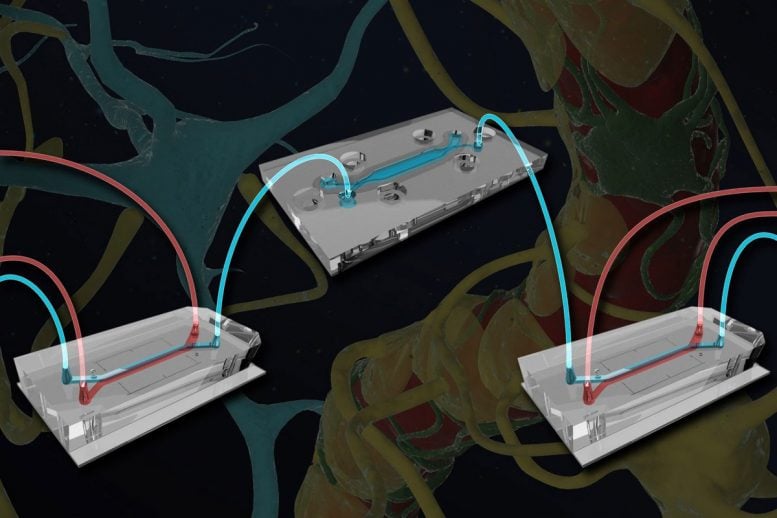
Researchers were able to trace the flow of molecules from the vasculature across the two blood-brain barrier chips and into the brain. Credit: Wyss Institute at Harvard University
The human brain is the most complex and delicate of all the body’s organs, and the one most in need of protection from toxins and other harmful substances — including those we deliberately ingest. But to understand the effects drugs and disease have on the brain, scientists have needed to study how blood vessels, brain cells, and the blood-brain barrier (BBB) influence each other.
That’s been a challenge. In vitro models, like cells in a dish, have been too simple, and in vivo models — human brain tissue — too complex. Now, as reported in Nature Biotechnology, researchers at the Wyss Institute for Biologically Inspired Engineering have created a “just right” model of the BBB-brain interface using microfluidically linked organ chips that react to drugs like methamphetamine the same way the human brain does. The linked chips give researchers an unprecedented look into how the brain’s vasculature influences and regulates its metabolic function.
“We realized that the brain is already so complex that we couldn’t analyze it on one chip, so we did the opposite and divided one organ onto multiple chips,” said first author Ben Maoz, a former technology development fellow at the Wyss who is currently an assistant professor at Tel Aviv University. “Organ chips were able to open up another dimension for neurological research that no other method could, decoupling a very dense organ to unveil new interactions between the different structures within the brain.”
How do you study something as complex as the human brain? Take it apart. Wyss researchers have created Organ Chips that mimic the blood-brain barrier and the brain and, by linking them together, discovered how our blood vessels and our neurons influence each other. Credit: Wyss Institute at Harvard University
The BBB is comprised of blood vessels and a unique network of supporting pericyte and astrocyte cells. The blood vessels supply the brain with oxygen and nutrients, and they are highly selective about which molecules they allow to cross from the blood to the brain, and vice versa. When the BBB is disrupted, as it is when it is exposed to methamphetamine (“meth”) and other drugs, the brain’s sensitive neurons become susceptible to harmful damage. In addition, the BBB is thought to directly interact with the brain and help regulate its functions.
To replicate the way that supply blood vessels, the neuronal compartment, and draining blood vessels are linked in the brain, the Wyss created an “influx” BBB chip, a brain chip, and an “efflux” BBB chip, all physically distinct but connected by microfluidic channels that allow the exchange of chemicals and other substances. The BBB chip has a channel lined with endothelial cells through which flows a culture medium that mimics blood, separated by a porous membrane from a parallel channel containing pericytes and astrocytes perfused with artificial cerebrospinal fluid (aCSF). The brain chip has a similar aCSF flow channel that is separated by another semipermeable membrane from a compartment containing human brain neurons and their supporting astrocytes.
The three chips’ aCSF channels are connected in a series, creating a fully linked system in which substances can diffuse from the vascular channel across the first BBB into the aCSF, enter the brain neuronal cell compartment, flow back into the aCSF, and ultimately diffuse out across the second BBB into another vascular channel, as happens in vivo.
The team cultured human cells in the linked BBB-brain chips and exposed them to meth, which is known to disrupt the junctions between the cells of the BBB in vivo and cause the barrier to “leak.” When meth was flowed through the BBB chip’s blood vessel channel, it compromised the junctions of its vascular endothelial cells and let through molecules that normally wouldn’t be able to cross. This experiment confirmed that the model worked, and could be used in research to better understand and develop treatments addressing drugs’ effects on the human brain.
Something in the chips that weren’t exposed to meth also caught the scientists’ attention. They realized that cells on BBB and brain chips that were fluidically linked and cells on unlinked chips expressed different proteins. For example, cells in all of the linked chips expressed higher levels of metabolism-associated proteins and lower levels of proteins involved in proliferation and migration than cells in unlinked chips, suggesting that the different cell types do in fact help each other maintain proper function.
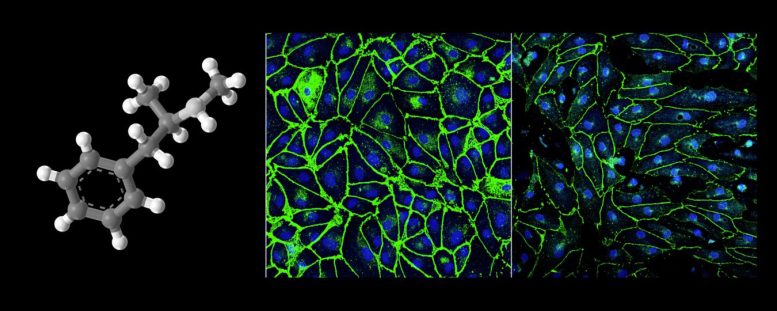
Methamphetamine (left) is known to disrupt the tight junctions (shown in green) between the cells of the blood-brain barrier (BBB), letting toxic substances enter the brain. When meth was added to healthy BBB cells (middle), it caused the junctions to become leaky (right), confirming that the BBB-brain chip system can be used to study the effects of drugs on the human brain. Credit: Wyss Institute at Harvard University
“Blood vessels are frequently thought to just be a barrier or a transporter of chemicals. But when we looked at the linked BBB-brain chips, we noticed that there seemed to be some crosstalk between the endothelial cells and the neurons,” said co-author Anna Herland, a former postdoctoral fellow at the Wyss Institute who is now an associate professor at the Royal Institute of Technology and the Karolinska Institute in Stockholm. “We also know from studies of long-term meth abusers that this drug affects the brain’s metabolism, so we started to dig deeper to see if we could characterize the metabolic link between the BBB and the brain.”
The modular nature of the BBB-brain chip system also allowed the researchers to individually analyze all of the molecules secreted by discrete cell populations, and then connect the chips to trace where they traveled. The chemicals secreted by cells on the uncoupled BBB chip were largely related to neuron maintenance and protection, demonstrating that the molecules produced by the BBB give neurons chemical cues.
To determine how the endothelium influences metabolites in the brain, the scientists administered radioactive carbon-labeled glucose, pyruvate, or lactate to brain chips that had been decoupled from the BBB chips. They found that the production of both glutamine and the neurotransmitter GABA was lower in unlinked brain chips than in chips linked to the BBB. This demonstrated that products of vascular endothelial cell metabolism become substrates for the production of neurotransmitters that mediate neuronal cell information processing in the brain — suggesting that the health of our blood vessels could directly impact mind function.
“The big breakthrough here is that we have teased out communication networks between cells in a way that never could have been done with traditional brain research techniques. In vivo studies simply do not offer the granularity to determine how complex these metabolic networks function in heterogeneous cell populations within living tissues,” said corresponding author Kit Parker, a core faculty member of the Wyss Institute and the Tarr Family Professor of Bioengineering and Applied Physics at the Harvard John A. Paulson School of Engineering and Applied Sciences.
“We are seeing here an unanticipated level of complexity that raises the bar in terms of what it will mean to successfully map the brain’s connectome.”
Reference: “A linked organ-on-chip model of the human neurovascular unit reveals the metabolic coupling of endothelial and neuronal cells” by Ben M Maoz, Anna Herland, Edward A FitzGerald, Thomas Grevesse, Charles Vidoudez, Alan R Pacheco, Sean P Sheehy, Tae-Eun Park, Stephanie Dauth, Robert Mannix, Nikita Budnik, Kevin Shores, Alexander Cho, Janna C Nawroth, Daniel Segrè, Bogdan Budnik, Donald E Ingber and Kevin Kit Parker, 1 October 2018, Nature Biotechnology.
DOI: 10.1038/nbt.4226
This work was supported by the Wyss Institute for Biologically Inspired Engineering, DARPA, the Sweden-America Foundation, the Carl Trygger Foundation, and the Erik and Edith Fernström Foundation.

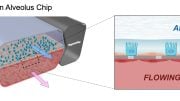

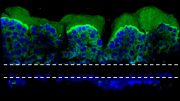
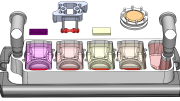


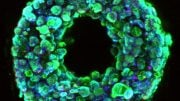
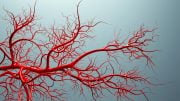
Be the first to comment on "New Organ on a Chip Lets Researchers Study Effects of Drugs and Disease"